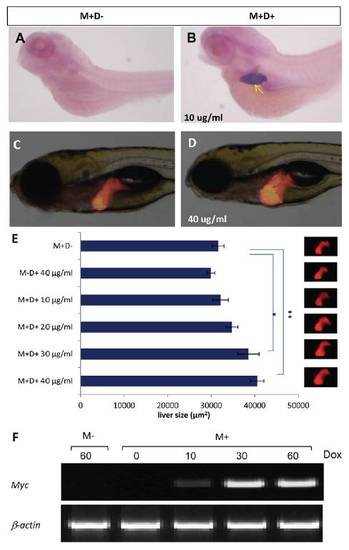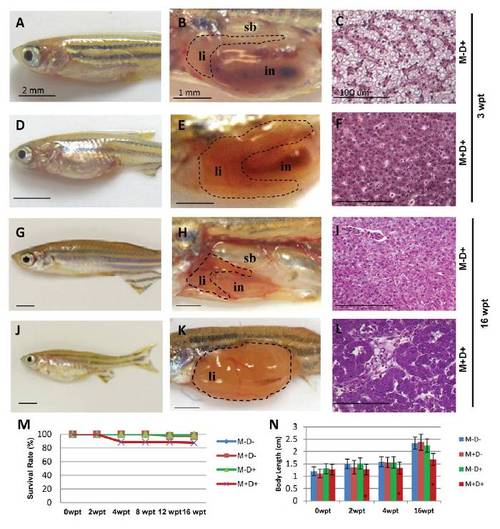- Title
-
A transgenic zebrafish liver tumor model with inducible Myc expression reveals conserved Myc signatures with mammalian liver tumors
- Authors
- Li, Z., Zheng, W., Wang, Z., Zeng, Z., Zhan, H., Li, C., Zhou, L., Yan, C., Spitsbergen, J.M., and Gong, Z.
- Source
- Full text @ Dis. Model. Mech.
|
Inducible Myc expression and liver overgrowth in TO(Myc) fry. (A,B)Liver-specific Myc expression in TO(Myc) fry. Myc transgenic fry were treated with 10 μg/ml Dox from 2 dpf for two days and liver-specific Myc expression was confirmed by whole mount in situ hybridization at 4 dpf, as indicated by a yellow arrow. An untreated control is shown in A. (C,D)In vivo detection of liver overgrowth in TO(Myc) fry. Double transgenic fry from a cross of TO(Myc) and LiPan zebrafish were treated with 40 μg/ml Dox and livers were observed by RFP expression (D). An untreated control is shown in C. (E)Dosedependent growth of liver in TO(Myc) fry. TO(Myc)/LiPan double transgenic fry were treated with increasing concentrations of Dox; liver imaging is shown in the pictures on the right. 2D measurement of liver areas were performed using ImageJ as described previously (Huang et al., 2012) and the quantitative data are shown on the left. The groups significantly different from the control group (M+D-) by Student′s t-test are indicated: *P<0.05; **P<0.01. (F)Dose-dependent induction of Myc mRNAs in adult livers as detected by RT-PCR. Concentrations of Dox are indicated at top of each lane. M+, TO(Myc) fish; M-, non-transgenic siblings; D+, presence of doxycycline; D-, absence of doxycycline. B-actin transcripts served as loading controls for RT-PCR. EXPRESSION / LABELING:
PHENOTYPE:
|
|
Induction of liver tumors in TO(Myc) fish. (A-L) Transgenic and non-transgenic fish were treated with Dox (60 μg/ml) starting from 21 dpf and sampled at different times. Samples were collected at 3 wpt (A-F) and 16 wpt (G-L). The left column displays external appearance, the middle column shows internal abdominal organs with the livers outlined, and the right column depicts H&E staining of liver sections. At 3 wpt, non-transgenic siblings had normal body shape (A), whereas transgenic fish showed an enlarged belly (D). Dissection of a transgenic fish (E) showed an enlarged abdomen compared to a non-transgenic sibling (B). At 16 wpt, more obviously enlarged abdomen (J) and fully grown liver tumor (K) were observed, in comparison with the controls (G,H). Histological examination confirmed that most transgenic fish developed hyperplasia (F) at 3 wpt and adenoma (L) at 16 wpt in comparison with normal liver histology in non-transgenic siblings (C,I). (M,N) Survival curves (M) and body lengths (N) for the four experimental groups until 16 wpt. Noted body length was significantly different from the control group after just 2 weeks of treatment; *P<0.0001. li, liver; in, intestine; sb, swimbladder. Scale bars: 2 mm, 1 mm and 100 μm for the left, middle and right columns, respectively. PHENOTYPE:
|


